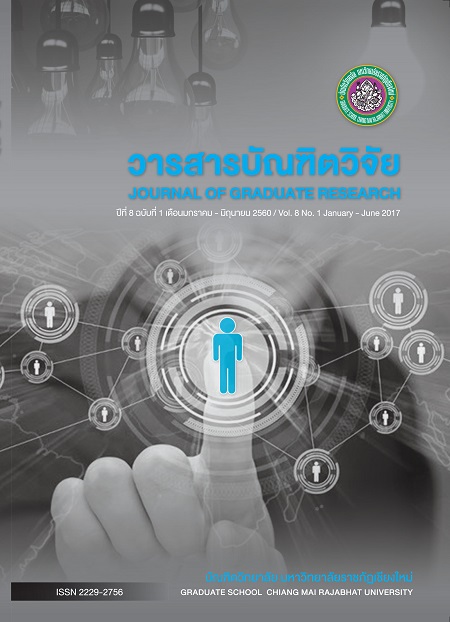ปัจจัยทำนายพฤติกรรมการใช้ถุงยางอนามัยของกลุ่มชายที่มีเพศสัมพันธ์กับชาย อำเภอเมือง จังหวัดเชียงใหม่
Main Article Content
บทคัดย่อ
การวิจัยครั้งนี้เป็นการวิจัยเชิงสำรวจแบบตัดขวาง (Cross-sectional survey study) มีวัตถุประสงค์เพื่อศึกษาพฤติกรรมการใช้ถุงยางอนามัยและทำนายปัจจัยที่มีความสัมพันธ์ต่อพฤติกรรมการใช้ถุงยางอนามัยในกลุ่มชายที่มีเพศสัมพันธ์กับชาย อำเภอเมือง จังหวัดเชียงใหม่ จำนวน 383 คน ซึ่งได้จากการคำนวณกลุ่มตัวอย่างโดยใช้สูตรของทาโร่ ยามาเน่ กำหนดระดับความเชื่อมั่นที่ 95% ความคลาดเคลื่อน 5% จากจำนวนประชากรกลุ่มชายที่มีเพศสัมพันธ์กับชายจากการคาดประมาณประมาณ 9,199 คน เก็บข้อมูลในช่วงเดือนมีนาคมถึงพฤษภาคม พ.ศ. 2559 โดยใช้วิธีการสุ่มตัวอย่างแบบต่อเนื่อง(Consecutive Sampling) จนได้กลุ่มตัวอย่างครบ เครื่องมือที่ใช้ในการเก็บรวบรวมข้อมูลคือแบบสอบถามที่ผู้วิจัยสร้างขึ้น ตามกรอบทฤษฎีการกระทำด้วยเหตุผล และได้ผ่านการตรวจสอบจากผู้เชี่ยวชาญ 3 ท่าน มีการทดสอบความเชื่อมั่นในแต่ละด้าน คือทัศนคติ บรรทัดฐานกลุ่มอ้างอิงด้านความเชื่อ และด้านแรงจูงใจ ได้ค่าสัมประสิทธิ์แอลฟา(Alpha Coefficient) ที่ระดับความเชื่อมั่น 0.80 ,0.80 และ 0.85 ตามลำดับ วิเคราะห์ข้อมูลเพื่อทำนายปัจจัยที่มีความสัมพันธ์ต่อพฤติกรรมการใช้ถุงยางอนามัย โดยใช้สถิติ Binary Logistic Regression
ผลการศึกษาพบว่า กลุ่มชายที่มีเพศสัมพันธ์กับชาย มีอายุเฉลี่ย 27.47 ปี เคยมีประวัติการเป็นโรคติดต่อทางเพศสัมพันธ์ ร้อยละ 36.55 มีพฤติกรรมการใช้ถุงยางอนามัยสม่ำเสมอร้อยละ 49.61 ปัจจัยที่มีความสัมพันธ์กับการใช้ถุงยางอนามัยในกลุ่มชายที่มีเพศสัมพันธ์กับชายอย่างมีนัยสำคัญทางสถิติ ได้แก่ รายได้มาก (Adjusted OR 1.92, 95% CI 1.12 – 3.25) การใช้ถุงยางอนามัยเมื่อมีเพศสัมพันธ์ครั้งแรก (Adjusted OR 2.26, 95% CI 1.41 – 3.62) การรู้วิธีใช้สารหล่อลื่น (Adjusted OR 2.50, 95% CI 1.45 – 4.33) การมีทัศนคติที่ดีมากในการใช้ถุงยางอนามัย (Adjusted OR 1.63, 95% CI 1.04– 2.55) บรรทัดฐานกลุ่มอ้างอิงด้านความเชื่อเกี่ยวกับความคาดหวังของบุคคลต่อการใช้ถุงยางอนามัยดีมาก (Adjusted OR 2.21, 95% CI 1.10 – 4.45) และบรรทัดฐานกลุ่มอ้างอิงด้านแรงจูงใจที่จะปฏิบัติตามความคาดหวังของบุคคลในกลุ่มผู้ใกล้ชิดดีมาก (Adjusted OR 2.27, 95% CI 1.10 – 4.67)
สรุป ทฤษฎีการกระทำด้วยเหตุผลสามารถนำมาประยุกต์ในการทำนายปัจจัยที่มีผลต่อพฤติกรรมการใช้ถุงยางอนามัยของกลุ่มชายที่มีเพศสัมพันธ์กับชายได้ ควรมีการสนับสนุน ส่งเสริมปัจจัยของทฤษฎีการกระทำด้วยเหตุผล รวมทั้งปัจจัยส่วนบุคคล ได้แก่ รายได้ การใช้ถุงยางอนามัยเมื่อมีเพศสัมพันธ์ครั้งแรก การรู้วิธีการใช้ สารหล่อลื่น ที่ได้จากการวิจัยครั้งนี้ เพื่อการป้องกันและควบคุมโรคที่เกิดจากการติดต่อทางเพศสัมพันธ์ ซึ่งจะส่งผลให้ลดอัตราการติดเชื้อเอชไอวีรายใหม่และลดการโรคติดต่อทางเพศสัมพันธ์ในกลุ่มชายที่มีเพศสัมพันธ์กับชายต่อไป
DETERMENANTS OF CONDOM USE BEHAVIOR AMONG MEN WHO HAVE SEX WITH MEN, MUEANG DISTRICT, CHIANG MAI PROVINCE.
This research was a cross sectional survey study.The purpose of this study was to examine condom behavior and determinants of condom use behavior among 383 men who have sex with men (MSM) in Mueang district, Chiang Mai province. A representative sample was calculated by using the formula of Yamane at the confidence level of 95% and error of sampling of 5% from the estimation of 9,199 MSM populations in Mueang, Chiang Mai Province. Data collection was performed during March to May in 2016 using the consecutive sampling. The content validity of the questionnaire was checked by 3 experts and also reliability was tested and the Cronbach alpha was 0.80, 0.80 and 0.85. Binary Logistic Regression was used for inferential analysis.
The results of the study were as follows: average age was 27.47 years (S.D. 8.24). Almost the sample using condoms consistently 49.61% had a history of STIs (36.55%). The sample who had high level of income use condom more than the sample who had least income level 1.92 times with statistical significance (Adjusted OR 1.92, 95% CI 1.12 – 3.25). The sample used condom at first time sexual intercourse than those who do not use 2.26 times with statistical significance (Adjusted OR 2.26, 95% CI 1.41 – 3.62). The sample who knows how to use it lubricated properly use condoms than those who do not know how to use it lubricated properly 2.50 times with statistical significance (Adjusted OR 2.50, 95% CI 1.45 – 4.33) The sample with high attitude toward condom use, use condom than those with moderate or least attitude 1.63 times with statistical significance (Adjusted OR 1.63, 95% CI 1.04 – 2.55) The sample with high belief of norm toward condom use, use condom than those who with moderate or least belief 2.21 times with statistical significance (Adjusted OR 2.21, 95% CI 1.10 – 4.45. And the sample with high motivation of norm toward condom use, use condom than moderate or least motivation 2.27 times with statistical significance (Adjusted OR 2.27, 95% CI 1.10 – 4.67)
The conclusion is Theory of Reason Action (TRA.) can be applied to predict the factors that condom use behavior among men who have sex with men. Subjects should be supported, promoting factors of TRA, including personal factors such as income, condom use at first sex and knowing how to use a lubricant, and to prevent and control diseases caused by sexually transmitted. This could lower infection rates of HIV and sexually transmitted infection new cases among men who have sex with men.


